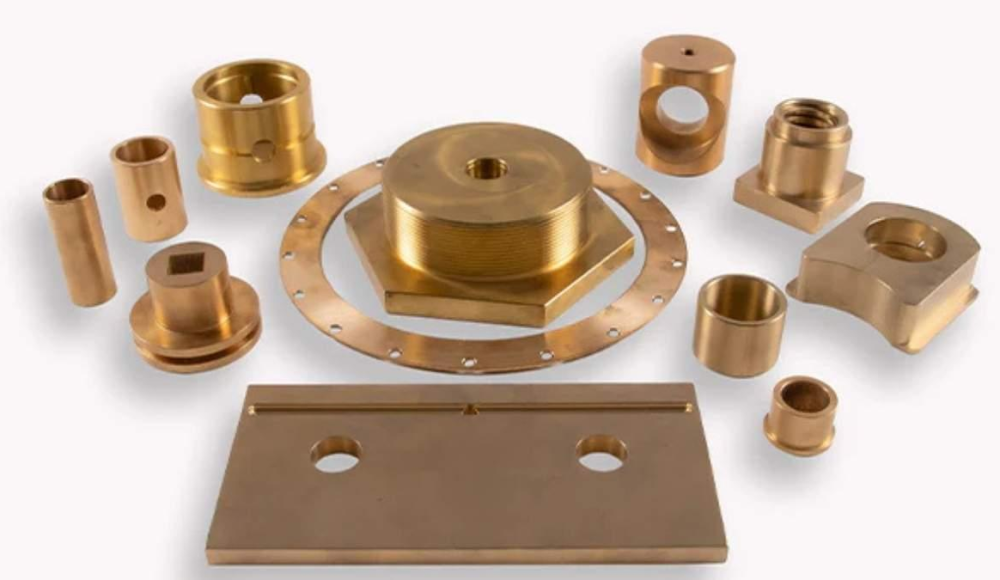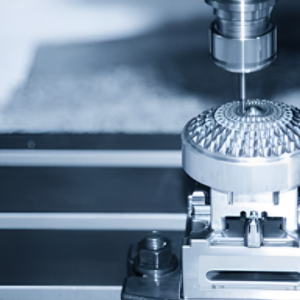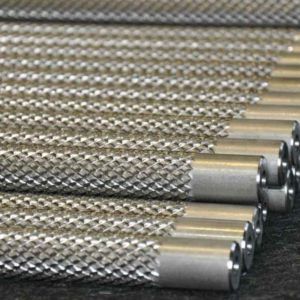سبائك البرونز تستلزم أداءً مذهلاً. وكثيرا ما تستخدم هذه في مقابض الأبواب والميداليات, لكن طلباتهم لا تنتهي هنا. علاوة على ذلك, ويستخدم البرونز في مكونات المحرك, أدوات, والمضخات. فضلاً عن ذلك, يتم استخدامه بشكل حيوي في أجراس ونوافير السفن الزينة.
فهم البرونزية
عادة ما يوجد معدن البرونز بلون بني محمر ينتمي إلى مجموعة “المعدن الأحمر”.. أنه يحتوي على 88% النحاس و 12% القصدير; إنه مرن نسبيًا وله العديد من الاستخدامات الصناعية. بالإضافة إلى ذلك, السبيكة أصعب من النحاس النقي, مما يجعل عمليات التصنيع أسهل. يعمل الاتصال المنخفض من المعدن إلى المعدن على تحسين إمكانية تطبيقه في الصناعات المختلفة. أحيانا, تعمل المكونات مثل الفوسفور أو الزنك على تعزيز خصائص البرونز. الصب يعني ذوبان البرونز, إضافة مواد أخرى ثم تبريدها في قوالب أساسية.
أنواع المعدن البرونزي
البرونز يشمل حولها 50 أنواع سبائك متميزة. للإيجاز, فيما يلي خمسة أصناف شائعة في التصنيع:
| النوع البرونزي | تعبير (عناصر إضافية) |
| برونز الألومنيوم | 6– 12% ألومنيوم |
| النيكل الألومنيوم البرونزية | 6– 13% ألومنيوم, ما يصل الى 7% حديد, 7% النيكل |
| برونز السيليكون | يصل إلى 6% السيليكون |
| الفوسفور البرونزي | يصل إلى 11% القصدير, 0.35% الفوسفور |
| برونز المنغنيز | يصل إلى 3% المنغنيز |
الخصائص الفيزيائية للبرونز
وفيما يلي الخصائص الفيزيائية الرئيسية للبرونز:
| ملكية | وصف |
| كثافة (ز/سم مكعب) | 5.60 - 9.30 |
| لون | بني محمر معدني |
| نقطة الانصهار (درجة مئوية) | 315 - 1180 |
| نقطة الغليان (درجة مئوية) | 1400 |
| توصيل حراري (ث/م-ك) | 1.01 - 208 |
الخواص الكيميائية للبرونز
يُظهر البرونز العديد من الخصائص الكيميائية المهمة:
| ملكية | وصف |
| المقاومة للتآكل | جيد |
| التوصيل الكهربائي | جيد |
| منتجات الأكسدة | أكسيد النحاس, كربونات |
| مغناطيسي | لا |
| المرونة | جيد |
| ليونة | عالي |
سبائك البرونز المشتركة
وتناقش أدناه سبائك البرونز المشتركة:
برونز الألومنيوم
يحتوي على برونز الألومنيوم الألومنيوم حول 9 ل 14%. لديها الشد العالي, أَثْمَر, مقاومة التآكل, والخصائص الميكانيكية. يعتبر برونز الألومنيوم مثاليًا للصناعات البحرية لأنه مقاوم للمياه المالحة, والقلويات. وتشمل المنتجات مراوح, الصمامات, والعديد من أجزاء السفينة الأخرى. كما أنها تناسب التروس والمحامل. القوة تشبه 50-55 HRC من الفولاذ الكربوني المتوسط.
تتضمن بعض الأمثلة العامة على برونز الألومنيوم:
- C95400 (برونز الألومنيوم)
- C95500 (برونز الألمنيوم المحتوي على الرصاص)
- C95800 (برونز ألومنيوم عالي القوة)
- C95900 (الألومنيوم البرونزي مع النيكل)
النيكل الألومنيوم البرونزية
يتميز النيكل ألومنيوم بخصائص النيكل والألومنيوم. توفر هذه السبيكة أداءً ممتازًا للتآكل في بيئات متميزة. لكن, مقاومة الحفر أعلى من تلك الموجودة في 300 سلسلة من الفولاذ المقاوم للصدأ. بجانب, إنها مناسبة تمامًا للتطبيقات البحرية والفضائية. تعد مرونة برونز النيكل والنيكل من نقاط القوة الرئيسية, وخاصة في اللحام.
تتضمن بعض الأمثلة العامة على برونز النيكل والألومنيوم:
- C95400 (النيكل الألومنيوم البرونزية)
- C95500 (النيكل المحتوي على الرصاص والبرونز والألومنيوم)
- C95800 (برونز ألومنيوم نيكل عالي القوة)
- C95900 (النيكل والألومنيوم والبرونز والمنجنيز)
القصدير البرونزي
برونز القصدير هو سبيكة برونزية قديمة, تتميز عادةً بخصائص صب جيدة ومضادة للتآكل. لديها القصدير يصل إلى 12% وبالتالي تستخدم للتروس والمحامل. لكن, يمكن أن تؤدي إضافة Tin Bronze إلى مشروع التصنيع إلى زيادة تكلفة المواد الإجمالية التي سيتم استخدامها في تصنيع المنتجات الإلكترونية.
تتضمن بعض الأمثلة العامة على برونز القصدير:
- C90200 (القصدير البرونزي)
- C90300 (برونز القصدير المحتوي على الرصاص)
- C90500 (برونز عالي القصدير)
- C90700 (الألومنيوم والقصدير البرونزية)
برونز المنغنيز
يتميز برونز المنغنيز بمقاومته العالية للتآكل بمياه البحر, مع الوصول إلى قوة الشد القصوى 110,000 رطل لكل بوصة مربعة. الاستخدامات المعتادة موجودة في المحامل, التروس, والمراوح المستخدمة في السفن البحرية.
بعض الأمثلة العامة للبرونز المنغنيز تشمل:
- C86300 (مرحبا الشد)
- C86400 (المنغنيز المحتوي على الرصاص)
- C86500 (الشد المنخفض)
- C86200 (ميد الشد)
تحمل البرونزية
يتم استخدام برونز القصدير عالي الرصاص في المحامل والبطانات. السبائك المذكورة أعلاه رخيصة نسبيًا وفعالة من حيث الأداء الوظيفي. LCR متصل بمحتوى القصدير. توزيع الرصاص يحسن القوة, مداهنة, والمطابقة. يمكن أن يعمل محمل البرونز عند درجة حرارة 450 درجة فهرنهايت / 230درجة مئوية. قدرتها الحمولة حوالي 4,000 رطل لكل بوصة مربعة.
تتضمن بعض الأمثلة العامة لتحمل البرونز:
- C93200 (القصدير البرونزي)
- C93700 (برونز القصدير المحتوي على الرصاص)
- C94300 (برونز الألومنيوم)
- C90500 (برونز عالي القصدير)
البرونزية مقابل. نحاس: الاختلافات الرئيسية
البرونزية و نحاس وتتميز بشكل رئيسي على أساس دستورها وخصائصها. كلاهما عبارة عن سبائك نحاسية ولا تتآكل بسهولة. لكن, يكوّن البرونز طبقة أكسيد على سطحه مع تقدم عمره. على الجانب الآخر, ومن المعروف أن النحاس له خاصية التشويه البطيء.
النحاس عبارة عن سبيكة تحتوي على النحاس, الزنك, وبعض المكونات الأخرى. تحدد هذه الجوانب لون هذا النوع من المعدن الذي يمكن أن يكون ذهبيًا أو فضيًا لامعًا. يمكن طرق النحاس لتشكيله بسهولة أكبر من البرونز, ولذلك فهو أكثر ليونة. هذه الخاصية تجعل النحاس قويًا بدرجة كافية ليتم طرقه ودحرجته دون أن ينكسر.
عملية تصنيع البرونز
كان البرونز مهمًا في تطوير الأدوات والأسلحة لعدة قرون. عملية إنتاج المادة معقدة ولكنها بسيطة. يتم تحضير هذه السبيكة الصلبة عن طريق تسخين القصدير والنحاس النقي بمجرد وصولهما إلى نقطة الانصهار. يجب بعد ذلك تبريد الغازات المختلطة وتصفيتها ثم صب الخليط المنصهر في قوالب طينية وتركها لتبرد. فيما يلي عمليات التصنيع الرئيسية المتعلقة بالبرونز:
قابلية التصنيع البرونزية
يمكن أن تؤدي معالجة البرونز المحمل إلى نتائج جيدة إذا تم إجراؤها بفعالية. عند تجهيز المشاريع, يؤدي استخدام سائل التبريد أو مواد التشحيم إلى تحسين جودة سطح المنتج النهائي. لأنه على الرغم من قوته الكبيرة إلا أنه يجب أخذ المخاطر بعناية أثناء العمليات. على سبيل المثال, يُنصح بسرعات أقل أثناء التوسيع بسبب "الإمساك".
مقاومة التآكل البرونزية
يتمتع البرونز بمستوى لا يصدق من التآكل, ويمكن استخدامه في الظروف التي لا تستطيع فيها المعادن الأخرى البقاء على قيد الحياة, كما هو الحال في المياه المالحة. إنه ذو تشطيب فريد يمكن صقله للحصول على لمعان أو الاحتفاظ به لإنتاج مظهر فريد, مظهر يشبه الصدأ بشكل معتدل.
التلدين البرونزي
ليس من السهل أن يصلب البرونز ويخفف التوتر. لذا, يجب أن يتم التلدين البرونزي بعناية من خلال التسخين. من الضروري الحفاظ على درجة الحرارة لمدة ساعة واحدة لكل بوصة من سمك الجدار عند 260 ج. لا يمكن القيام بذلك بمعدل سريع وإلا فإنه قد ينهار, والكسر. العمل على برونز السيليكون الذي يحتوي على نسبة أعلى من الرصاص, يتطلب المزيد من الحذر, وينبغي مراعاة التدابير اللازمة مثل ارتداء الملابس الواقية المناسبة ومنهجيات الاستخراج الصحيحة.
صب البرونز
تم استخدام صب البرونز لإنتاج روائع من المعدن المنصهر لعدة قرون. وهذا يشمل صنع الآلات الموسيقية, منحوتات, الجوائز, وما إلى ذلك التي تستخدم عمليات مثل الشمع المفقود, قذائف السيراميك, أو الرمال. يتبع الحرفيون عملية دقيقة ويستخدمون تقنيات مختلفة لصب البرونز المنصهر في قوالب لإنشاء أعمال فنية كبيرة.
القابلية للتشكيل والليونة
مثل معظم المعادن, ويمكن أيضًا تشكيل البرونز عند درجات حرارة منخفضة لتحسين قوته وصلابته. خصائص الاحتكاك المنخفض للبرونز المحمل تجعله مناسبًا للاستخدام في العديد من التطبيقات. على سبيل المثال, ينتج الجرس البرونزي أصواتًا رنانة, والعديد من سبائك البرونز الأخرى تظهر مقاومة ممتازة للتآكل بمياه البحر.
الأهم من ذلك, البرونز مطاوع, ومن الممكن سحبها إلى أسلاك رفيعة دون كسرها. هذه الخاصية جديرة بالاهتمام بشكل خاص في المولدات في جميع أنحاء العالم التي تثبت قدرات المعدن.
مميزات البرونز
- القوة أعلى من نقاء النحاس أو الحديد.
- مستوى كبير من مقاومة التآكل يحسن متانته.
- موصلية حرارية وكهربائية أعلى من معظم أنواع الفولاذ.
- يبدو أن قوة التعب متفوقة على العديد من السبائك.
- ذوبان أعلى وبالتالي الصب أسهل.
- ومن المهم أيضًا أن نقول إن الاحتكاك المنخفض بين المعدن والمعدن يعد ميزة في التطبيقات الميكانيكية.
- في كل مكان حول سهولة الاستخدام, والكفاءة في العديد من التطبيقات التي يتم استخدامها من أجلها.
- يوفر طلاء سطحي عالي الجودة.
عيوب البرونزية
- البرونز أكثر عرضة للأكسدة من سبائكه, نحاس.
- في بعض الأحيان يكون أكثر تكلفة من الفولاذ, نحاس, أو النحاس.
- المركب عرضة للتدهور بسبب مركبات الحديديك والأمونيا.
- يمكن تسريع تلف الكبريت والكلور بسبب الظروف الرطبة.
- قد يتطور مرض البرونز, ويتجلى ذلك من خلال بقع خضراء شاحبة على الجلد.
- إذا لم يتم معالجة هذه الحالة فإنها تؤدي إلى تدهور شديد.
خاتمة
لتلخيص, يستحق البرونز أن يطلق عليه مستوى من أنواع السبائك المبتكرة والمرنة. لديها مجموعة من الخصائص الميكانيكية المرغوبة ومقاومة التآكل. على الرغم من أن لها عيوبها, والتي تشمل التكاليف المرتفعة والحساسية لظروف بيئية معينة, المزايا التي تعود على تنفيذ هذا النهج هي أكثر فائدة. أخيرا, ويتبين أن البرونز يبقى مادة أساسية في صناعة مؤشر واضح على أهميته. اتصل بنا للمزيد من المعلومات.
الأسئلة الشائعة
1. كيف تتم إضافة القصدير (سن) تغيير النحاس (النحاس) لإنشاء البرونزية?
إضافة القصدير (سن) يغير بشكل أساسي الخواص الميكانيكية للنحاس (النحاس) خلال تعزيز الحل الصلب. النحاس النقي ناعم للغاية ومرن. عن طريق إدخال ذرات القصدير في الشبكة البلورية النحاسية, تشوه ذرات القصدير البنية المنتظمة. وهذا التشوه يجعل من الصعب بشكل كبير على الطائرات الذرية أن تنزلق فوق بعضها البعض, مما أدى إلى وجود البرونزية صلابة أعلى, زيادة قوة الشد, ومقاومة التآكل متفوقة مقارنة بالنحاس النقي.
2. ما هو "مرض البرونز","ولماذا يعتبر ذلك مصدر قلق كبير بالنسبة للقطع الأثرية?
مرض البرونز هو محدد, شكل مدمر من التآكل الذي يؤثر في المقام الأول على القطع الأثرية البرونزية القديمة, وخاصة تلك المعرضة للرطوبة والكلوريدات (على سبيل المثال, من مياه البحر أو التربة). وهو تفاعل تحفيزي حيث كلوريد النحاسوز (CuCl) يتفاعل مع الماء والأكسجين لتكوين حمض الهيدروكلوريك (حمض الهيدروكلوريك), والذي بدوره يؤدي إلى تآكل المزيد من النحاس. يبدو على شكل مسحوق, بقع خضراء شاحبة. إذا لم يتم علاجها, هذه الحالة يمكن أن تنتشر بسرعة و تنهار وتدمر تماما الكائن البرونزي.
3. لماذا هو الألومنيوم البرونزية (البرونزية) مفضل خصيصًا للاستخدام في البيئات البحرية?
يُفضل استخدام برونز الألومنيوم في التطبيقات البحرية لأن محتوى الألومنيوم يتسبب في تكوين السبيكة بشكل تلقائي لمادة مستقرة للغاية, رفيع, طبقة سطحية واقية أكسيد الألومنيوم (Al2O3). هذه الطبقة مقاومة للغاية للتآكل, وخاصة الآثار المسببة للتآكل المياه المالحة (أيونات الكلوريد) والأحماض الخفيفة, تقديم أداء أفضل من العديد من السبائك الأخرى القائمة على النحاس في مكونات السفن, الصمامات, والمراوح.
4. كيف يؤدي (الرصاص) تحسين أداء "تحمل البرونز"?
يضاف الرصاص إلى برونز القصدير (برونز القصدير عالي الرصاص) لتحسين أدائها كمواد تحمل. لا يختلط الرصاص مع مصفوفة النحاس/القصدير; بدلاً من, يبقى كما هو صغير, جزيئات ناعمة متناثرة بدقة. يوفر محتوى الرصاص هذا فائدتين رئيسيتين:
-
مداهنة: تعمل جزيئات الرصاص الناعمة كمواد تشحيم صلبة, تقليل الاحتكاك ومنع الاتصال من المعدن إلى المعدن.
-
المطابقة: يسمح الرصاص الناعم لسطح المحمل بالتوافق قليلاً مع المخالفات الموجودة في العمود, منع ارتفاع درجة الحرارة الموضعية والنوبات.
5. ما هو الفرق الوظيفي الرئيسي بين النحاس والبرونز في التطبيقات الهندسية?
| ميزة | نحاس (النحاس + الزنك) | برونزية (النحاس + سن) |
| الملكية الأساسية | قدرة ميكانيكية ممتازة (من السهل قطع / الشكل) | صلابة عالية, قوة, وارتداء المقاومة |
| الاستخدامات الشائعة | تركيبات السباكة, الأجهزة الزخرفية, الات موسيقية. | رمان, التروس, الصمامات, مراوح بحرية, والمسبوكات الهيكلية. |
| تَحمُّل | أكثر ليونة (أسهل للتشوه). | أكثر صرامة, أكثر ملاءمة للظروف عالية التحميل والكاشطة. |
6. لماذا ينصح بسرعة أقل أثناء توسيع سبائك البرونز؟?
يُنصح بسرعات أقل أثناء التوسيع (عملية الانتهاء من حفرة) لبعض سبائك البرونز, وخاصة تلك التي تحتوي على الرصاص أو القصدير العالي, لتجنب ظاهرة تعرف باسم "الاستيلاء". يمكن أن تكون سبائك البرونز لزجة أو ناعمة نسبيًا مقارنة بالفولاذ, وقد يؤدي تشغيل مخرطة الثقب بسرعة كبيرة إلى قيام الأداة بقضم المادة بقوة, يحتمل أن يسبب الثرثرة, الانتهاء من سوء السطح, أو كسر الأداة. تسمح السرعات البطيئة بمنظف, قطع تسيطر عليها.
7. إلى ماذا يشير مصطلح "LCR" في سياق تركيبة Bearing Bronze?
في سياق تحمل البرونز (مثل C93200), LCR غالبا ما يقف ل نسبة النحاس المحتوي على الرصاص أو بشكل عام يشير إلى يقود, نحاس, والمتبقية محتوى العنصر. وجود الرصاص وتوزيعه بدقة (الرصاص) تعتبر نسبة إلى مصفوفة النحاس والقصدير من المعلمات الحاسمة التي تحدد قدرات التشحيم ومكافحة الاحتكاك للسبائك.




1 فكرت في "كل شيء عن المعدن البرونزي”